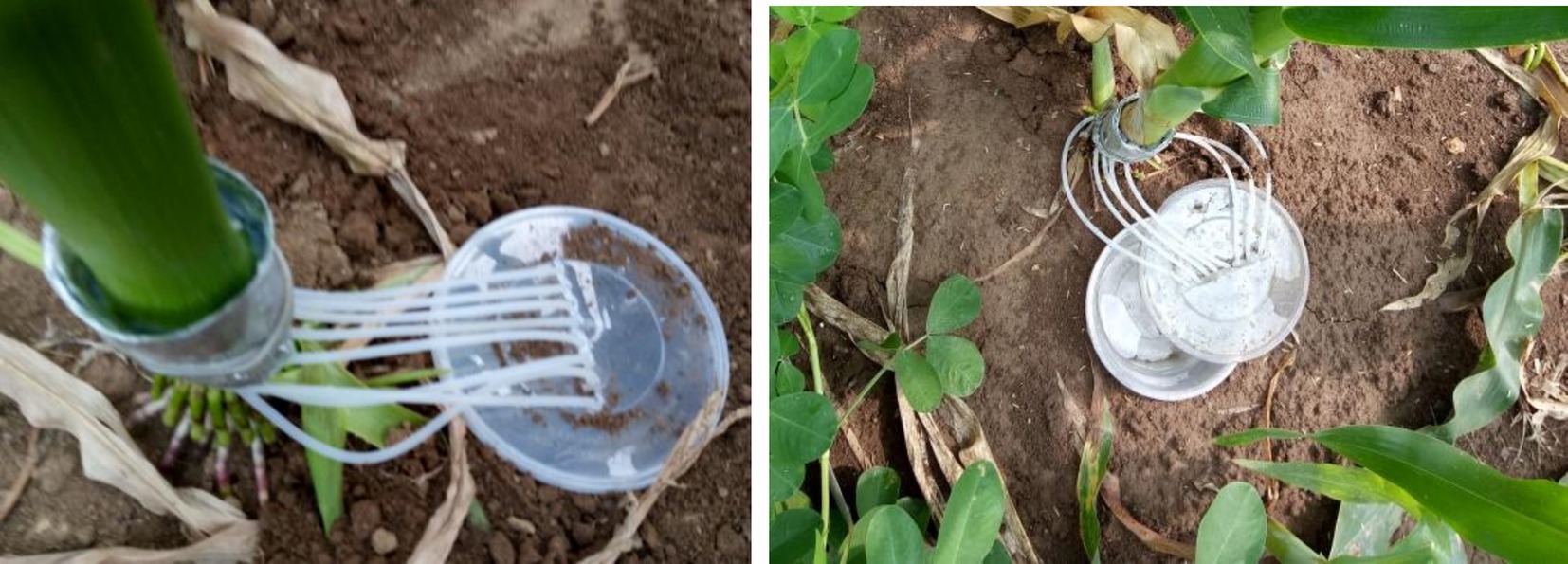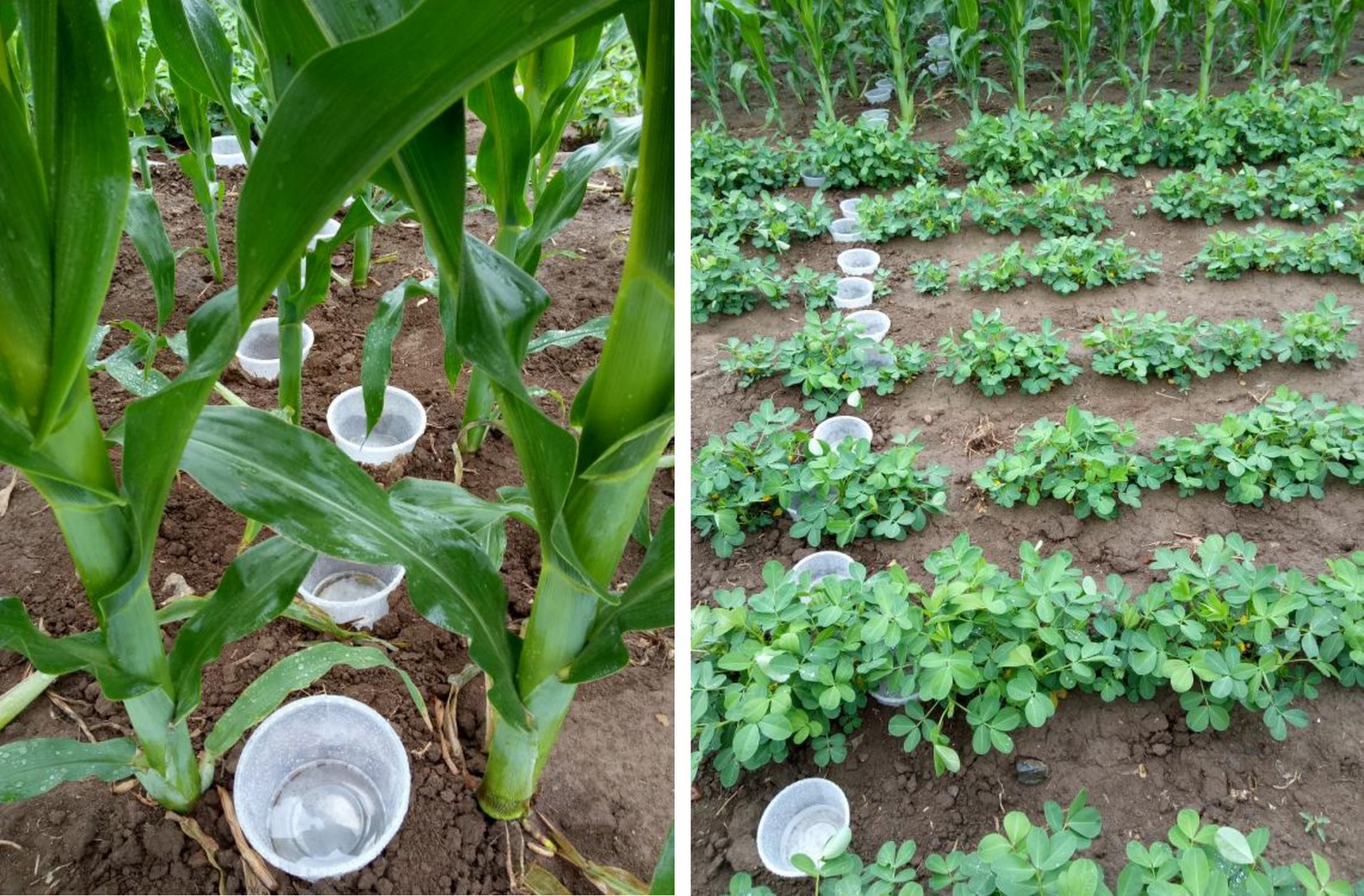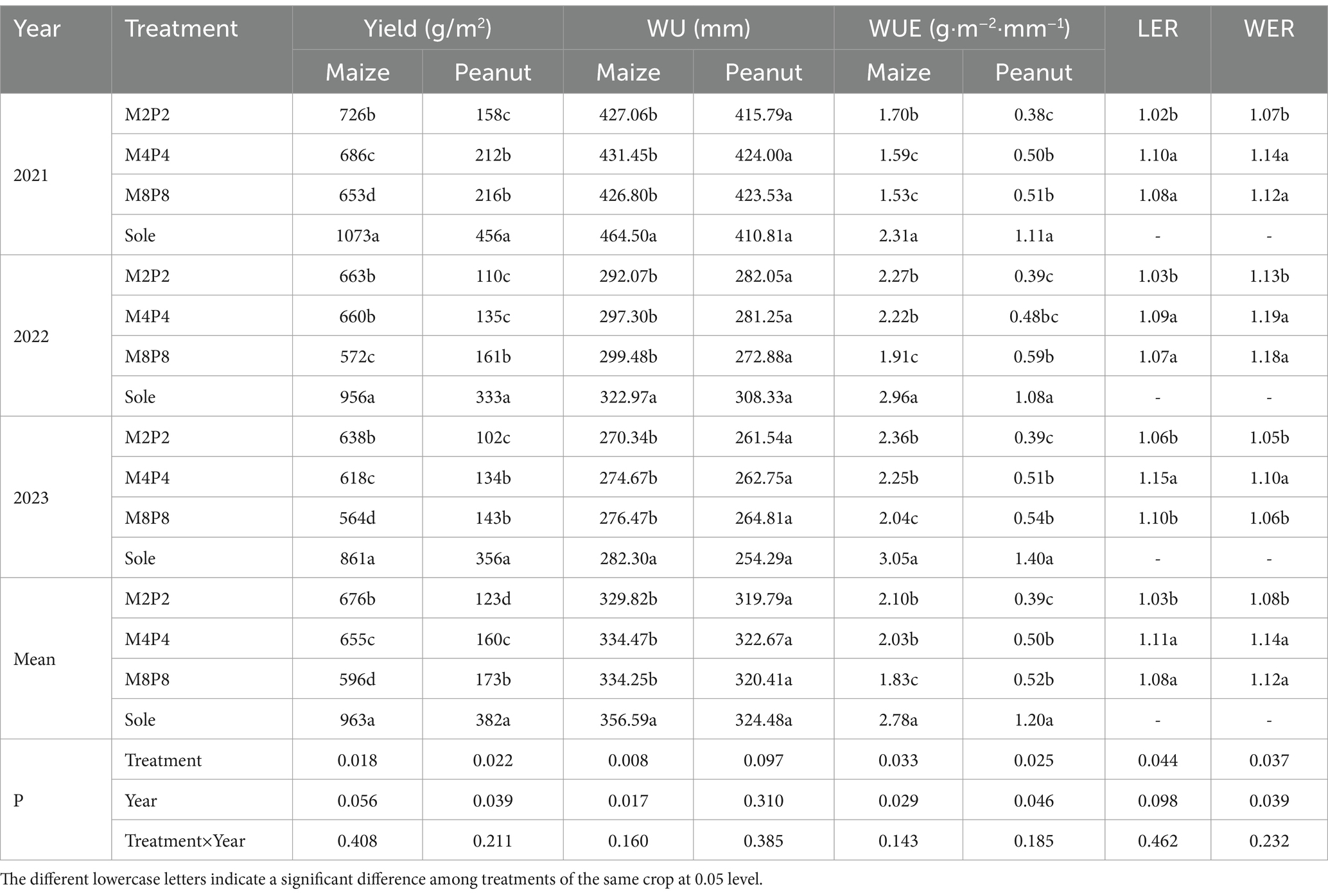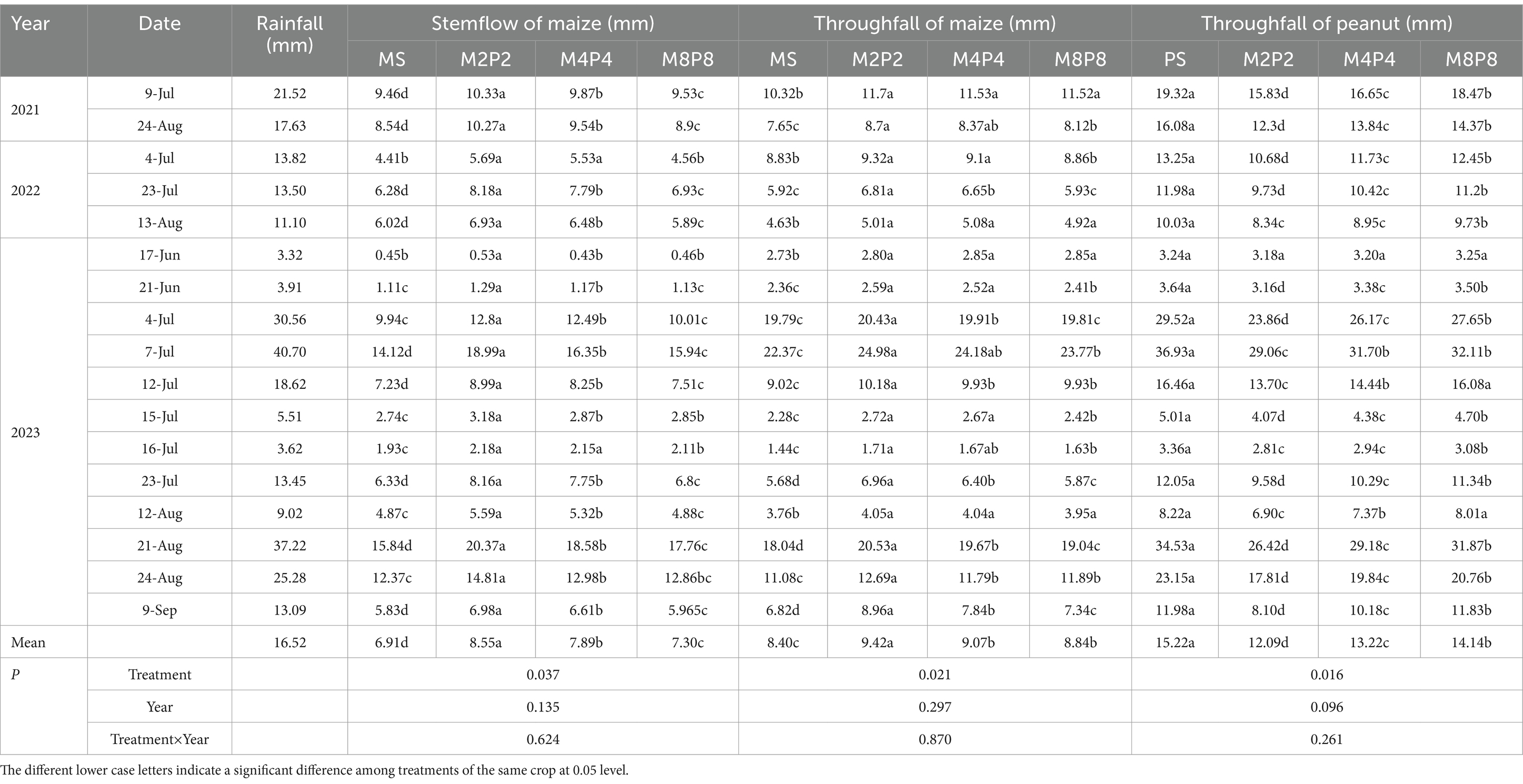- 1College of Water Conservancy, Shenyang Agricultural University, Shenyang, China
- 2College of Land and Environment, Shenyang Agricultural University, Shenyang, China
- 3Liaoning Academy of Agricultural Sciences, Shenyang, China
- 4Plant Protection College, Shenyang Agricultural University, Shenyang, China
Introduction: Maize and peanut intercropping can optimize allocation of rainfall through crop canopies, enhancing crop resilience to drought. However, the mechanisms underlying this process remain unclear.
Methods: This study investigates the impact of strip width on rainfall redistribution to the soil in maize (MS) and peanut (PS) monoculture systems, as well as in intercropping systems with strip configurations of 2:2 (M2P2), 4:4 (M4P4), and 8:8 (M8P8).
Results and discussion: Results showed that maize/peanut intercropping consistently improved system water use efficiency (WUE) over the three-year experiment, with the M4P4 treatment maintaining the highest WUE throughout. Strip width significantly influenced stemflow and throughfall in maize rows, as well as throughfall in peanut rows, with maize plant height and leaf area playing key roles. Among the 17 rainfall events studied, maize rows in the M2P2, M4P4, and M8P8 treatments obtained 17.4%, 10.8%, and 5.4% more rainfall, respectively, compared to the MS. However, compared to PS, water captured by intercropped peanut rows decreased by 20.6%, 13.2%, and 7.1%, respectively. An edge effect was observed in the intercropping treatments, with stemflow in maize rows increasing by 23.7%, 17.8%, and 14.6%, and throughfall by 12.2% (M2P2), 10.6% (M4P4), and 8.6% (M8P8) compared to MS. Conversely, the M2P2, M4P4, and M8P8 treatments decreased throughfall in peanut by 20.6%, 18.0%, and 16.0%, respectively, compared with PS. Overall, our findings suggest that optimizing strip width in intercropping systems can improve both crop productivity and water management, offering insights for sustainable agricultural practices in regions with limited water resources.
1 Introduction
As global climate change intensifies, extreme weather events and natural disasters, such as droughts, are becoming more frequent and severe, posing significant challenges to agricultural production and farmer livelihoods (Lou et al., 2024). To ensure sustainable and stable agricultural systems, farming practices that can adapt to these adverse conditions are essential (Lou et al., 2024; Chimi et al., 2024). The relationship between biodiversity and ecosystem stability has been extensively studied following the development of the diversity-stability hypothesis (Odum, 1953; MacArthur, 1955). Intercropping—a practice where two or more crop species are grown together for all or part of their growing season—has gained attention as a strategy for increasing biodiversity in agricultural systems (Feng et al., 2021; Pelech et al., 2023). By diversifying agricultural systems, intercropping can enhance crop production and improve resilience to stresses, such as drought, through optimizing resource use and system adaptability (Renwick et al., 2020; Nelson et al., 2022).
To maximize the benefits of intercropping, selecting appropriate crops and designing suitable intercropping configurations are essential (Brooker et al., 2015). Additionally, crop characteristics such as canopy structure (Chai et al., 2014), root system depth (shallow or deep) (Xia et al., 2013), and growth stages (Zhang et al., 2017) must also be considered. Recent research aimed at improving drought resistance and yield stability in intercropping systems has primarily focused on nutrient and water use (Feng et al., 2024; Zhang et al., 2024b; Ma et al., 2019). For instance, in maize/soybean intercropping systems, the root length density of both maize and soybean is higher than in monocultures, which enhances water uptake and improves drought resistance (Ren et al., 2017). However, there has been less focus on the impact of aboveground configurations on the water use efficiency of intercropping systems.
Rainfall is intercepted by the canopy and is then distributed as stemflow and throughfall into the soil (Nanko et al., 2016). Stemflow refers to the volume of water that flows down the plant stem to the roots after being captured by the plant canopy (Lamm and Manges, 2000). Throughfall, on the other hand, is the portion of rainfall that reaches the soil through gaps or complex structures in the canopy, representing a significant form of rainfall under crop canopies (Zhu et al., 2021; Guo et al., 2023). Thus, appropriately structured canopies can ensure drought resistance, stable yields, and efficient resource utilization (Yang et al., 2017; Nelson et al., 2018). The canopy, composed of stems, branches, and leaves, acts as the interface between the plant and its environment (Franco et al., 2018). Generally, in response to drought stress, crops modify their plant height, leaf area, number of branches or tillers, number of reproductive organs, growth period length, stomatal closure, direction of photosynthetic assimilate transport, enzyme composition, and genetic structure—collectively known as “growth redundancy” (Gao et al., 2020; Ye et al., 2020; Nehe et al., 2021). In intercropping systems, interactions between species can affect canopy development. For instance, intercropping maize and peanuts significantly alters the plant canopy structure compared to monocultures. Peanuts have abundant branches and leaves, shorter plant height, and better surface coverage (Tahir et al., 2016). This structure reduces the diffusion resistance of the boundary layer and minimizes soil moisture evaporation, facilitates airflow, and significantly improves the overall transpiration efficiency of both crops. While the relationship between canopy structure and drought resistance is better understood in monoculture systems, crops in intercropping systems exhibit similar adjustments.
A semi-arid region in northeastern China lies at the intersection of the Mongolian Plateau and Northeast Plain. This area receives annual precipitation ranging from 350 to 500 mm, though this amount fluctuates significantly from year to year, leading to low and variable crop yields (Lu and Shi, 2024). The main crops in this region are maize and peanuts (Feng et al., 2021). Maize, an essential food crop, has high water-use efficiency, but its tall stature and high rates of transpiration and evaporation result in substantial water demands. This increases the risk of poor harvests in the semi-arid region (Zhang et al., 2024a). In contrast, peanuts require less water than maize, and are more drought tolerant (Feng et al., 2021). Therefore, intercropping maize and peanut helps optimize the limited water supply in drylands and improve agricultural resistance to drought. Intercropping can also block and reduce deep leakage and surface runoff of rainwater and irrigation water in maize and peanut canopy layers, improve usage of rainfall, and enhance soil water storage capacity, with significant economic benefits (Feng et al., 2016; Hamd-Alla et al., 2023). Additionally, Intercropping maize and peanut can also stagger critical periods of crop water demand and reduce interspecies competition, which is important for efficient water use in intercropping systems (Chauhan et al., 2015). However, little is known about how combining maize and peanut crops affects the passage of water flow into soils.
We investigated the impact of maize canopy structure and strip width on water flow in intercropped maize and peanut systems. Our objective was to evaluate whether intercropping could improve both agricultural stability and productivity in semi-arid, drought-prone regions, while also identifying more suitable planting patterns for these areas.
2 Methods
2.1 Experimental site
The experiment was conducted from 2021 to 2023 at the Jianping County Irrigation Experimental Station (41°47′18″ N, 119°18′36″ E, 512 m above sea level), located in Chaoyang City, Liaoning Province, China (Supplementary Figure S1). The site is situated in a transitional zone between arid and semi-arid climates and experiences a monsoon continental climate. The area has an average annual temperature of 7.1°C, a total effective accumulated temperature of 3,200°C, and a frost-free period of 125–133 days. Annual evaporation averages 1800 mm, while total annual precipitation is 451.2 mm. Rainfall exhibits significant interannual variability, with frequent droughts occurring in the spring. The dominant soil type is cinnamon soil with a sandy loam texture. The soil has a maximum field water-holding capacity of 25.4%, a bulk density of 1.4 g cm−3, and contains 1.21% organic matter, 320 mg kg−1 total nitrogen, 13.6 mg kg−1 Olsen phosphorus, and 110.1 mg kg−1 available potassium. During the crop growth periods of 2021, 2022, and 2023, the total rainfall was 527 mm (wet year), 283.6 mm (normal year), and 233.7 mm (dry year), respectively(Supplementary Figure S2). The rainfall redistribution between maize and peanut was measured 17 times over three years: 2 times in 2021, 3 times in 2022, and 12 times in 2023.
2.2 Experiment design
Maize (‘Zhengdan 958’) and peanut (‘Baisha 1016’) varieties were grown under five different treatments: maize sole crop (MS); peanut sole crop (PS), intercropping with two rows of peanut and two rows of maize (M2P2), intercropping with four rows of peanut and four rows of maize (M4P4), and intercropping with eight rows of peanut and eight rows of maize (M8P8). Each treatment was replicated four times, with each plot measuring 10 × 20 m. Planting rows were oriented north–south, with a row spacing of 50 cm (Figure 1). The maize was planted at a density of 67,300 plants ha−1 (plant spacing was 29.7 cm), while the peanut was planted at a density of 268,000 plants ha−1 (hole spacing was 14.9 cm, 2 plants per hole). From 2021 to 2023, only basal fertilizer was applied during sowing, which was a compound fertilizer, consisting of 112 kg ha−1 N, 112 kg ha−1 P2O5 and 112 kg ha−1 K2O. Maize and peanut were sown simultaneously on May 12th, May 13th, and May 15th in 2021, 2022, and 2023, respectively, with harvesting occurring on September 30th, September 29th, and September 27th in the same years. Except during the spring drought in 2023, when crops were irrigated with 10 mm of water after sowing to ensure seedling emergence, no irrigation was applied during other growth periods.
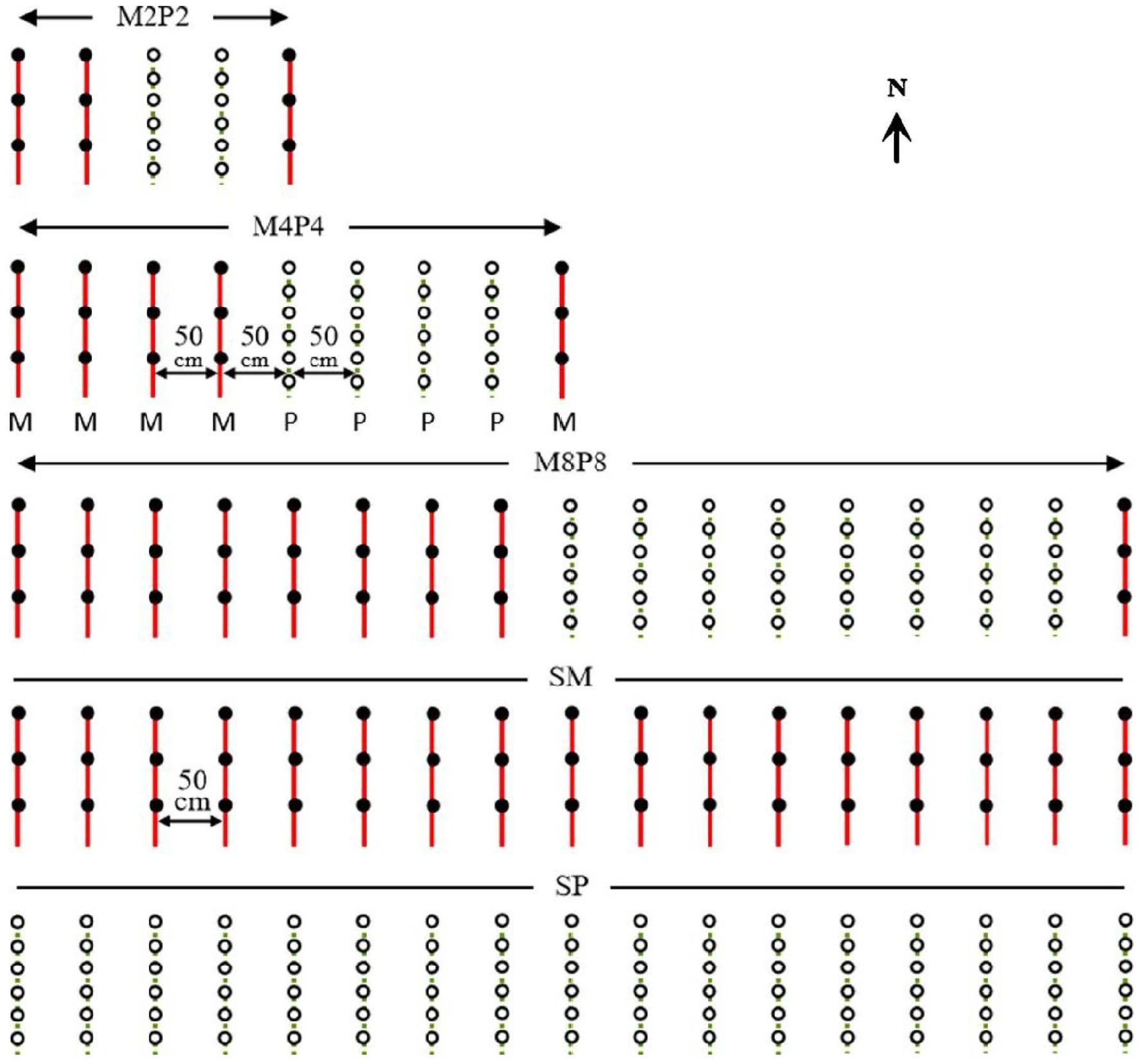
Figure 1. Layout of maize/peanut strip intercropping and sole systems. Solid circles in red lines represent maize plants and open circles in green dashed lines indicate peanut plants.
2.3 Measurements
2.3.1 Rainfall
Real-time rainfall data were recorded using an automatic weather station (DZZ6, Zhong Huan Tig), installed in an open area approximately 10 meters from the experimental site. The experimental field has a flat terrain, and since it is an arid region, the runoff volume was not measured.
2.3.2 Stemflow
To measure stemflow, a funnel was attached to the base of selected maize stems, following a modification of the method described by Lamm and Manges (2000). To ensure complete collection of the stemflow, a gap of more than 1 cm was kept between the top edge of the funnel and the maize stem. The bottom of the funnel was sealed to the maize stem using a mastic sealant to prevent any leakage. Eight guide pipes inserted into the bottom of the funnel connected to a water-collection bucket, which was covered to prevent any water other than stemflow from entering (Figure 2). Stemflow was standardized by dividing collected flow by the average area occupied by a single maize plant. Three measurement points were placed in parallel within each plot, with the distance between them exceeding 2 m.
Stemflow per plant was calculated as follows:
where SF is stemflow (mm), SFg is stemflow mass (g), ρ is liquid density (g cm−3), and A is canopy-occupied area by each maize plant (cm2).
The stemflow rate is a ratio of stemflow to rainfall during a rainfall event, calculated as follows:
Where SR is stemflow rate (%) and RF is rainfall during a rainfall event (mm).
2.3.3 Throughfall
For measuring throughfall, buckets of the same size as those used for stemflow measurements were placed on or in each ridge/furrow beneath the crop canopy (Figure 3). In the intercropping system, the maize canopy overlapped with the peanut canopy, meaning that the maize canopy influenced the throughfall in the peanut strips. Therefore, the rainfall that penetrated the peanut strips was also measured. Measurements were taken three times in parallel for each plot. The throughfall rate was calculated as the ratio of throughfall to total rainfall during a rainfall event, using the following formula:
Where TR is throughflow rate (%) and RF is rainfall during a rainfall event (mm).
2.3.4 Plant height and leaf area
Plant height and leaf area were measured following each rainfall event. Five plants were randomly selected from each plot for these measurements. Plant height was measured from the ground to the highest point of the fully extended plant, while leaf area (including senescing leaves) was measured using a portable leaf area meter (YMJ-G, Laiyin Technology, Weifang, China).
2.3.5 Yields
After harvest, the crop yields from each plot were measured individually. The sampling area for yield measurement in each community was 10 m2, and the yield of maize grains and peanut kernels was measured after air-drying.
2.3.6 Soil moisture content
Soil moisture content at different depths (from 10 cm to 100 cm) was measured before sowing and after harvest for each treatment. For the calculation of water consumption, soil volumetric moisture content was calculated based on the soil bulk density.
2.3.7 Land equivalent ratio
The Land equivalent ratio (LER) is used to assess the land utilization efficiency of intercropping (Feng et al., 2016), and was calculated as follows:
Where Yint,A and Yint,B represent the intercropping yields of crop A (maize) and crop B (peanut), respectively. Ysole,A and Ysole,B represent the sole crop yields of crop A and crop B, respectively. LERA and LERB are the partial land equivalent ratios of crop A and crop B. A LER greater than 1 indicates that the land utilization efficiency of the intercropping system is higher than that of sole cropping.
2.3.8 Water equivalent ratio
The water equivalent ratio (WER) is defined similarly to the LER (Feng et al., 2016). WER quantifies the amount of water that would be required in sole cropping to achieve the same yield as produced with one unit of water in an intercropping system. If the WER > 1, it indicates that the water utilization efficiency of intercropping is higher than that of sole.
Where WUEsole,A and WUEsole,B are the water use efficiencies of sole cropping for A and B. WUEint, A and WUEint, B are water use efficiencies of crops A and B in the intercropping system. These WUE values are calculated as the yield of crop A or B per unit of total water used in the intercropping system. Y is yield. WUint is actual evapotranspiration of the entire intercropping system, WUsole, A and WUsole, B are the actual evapotranspiration values for crops A and B in sole cropping. The specific measurement method was the same as that described by Mao et al. (2012).
2.4 Statistical analysis
Data analysis (ANOVA) was performed using SPSS 19.0 (IBM Corporation), and regression equation simulation and plotting were conducted using Origin 2025.
3 Results
3.1 Crop productivity and water use efficiency
Results on crop yields from 2021 to 2023 showed that planting patterns significantly influenced crop yields (Table 1). Because maize-peanut intercropping was considered as a whole, the planting ratio of a certain crop in intercropping was lower than that in sole, so its yield was also lower than that of sole. The yield of intercropped maize increased as the strip width narrowed, while peanut yield showed year-to-year variability. The LER of maize-peanut intercropping was greater than 1, indicating that this intercropping system can enhance land productivity. Water utilization (WU) in intercropped maize was lower than in MS, although the differences between treatments varied from year to year. While no significant difference was observed between intercropped and sole-cropped peanut. The water use efficiency (WUE) is a direct indicator of water use efficiency in intercropping systems. Since the LER of maize-peanut intercropping was greater than 1, it suggested that this system improved water use efficiency. The WER for M4P4 remained consistently high across the years, while that of M2P2 was relatively lower. In 2021, a wet year, and 2022, a normal year, no significant difference in WER was found between M4P4 and M8P8. However, in 2023, a dry year, M4P4 exhibited the highest water use efficiency.
3.2 Effects of strip width of intercropping on maize plant height and leaf area
The leaf area of intercropped maize was greater than that of sole-cropped maize, with the following ranking: M2P2 > M4P4 > M8P8 > MS (Figure 4A). Compared with sole-cropped maize, plant height was higher in 2022 (normal year) and 2023 (dry year) but lower in 2021 (wet year) (Figure 4B). These results indicated that both rainfall and planting patterns had a significant impact on plant height in this region.
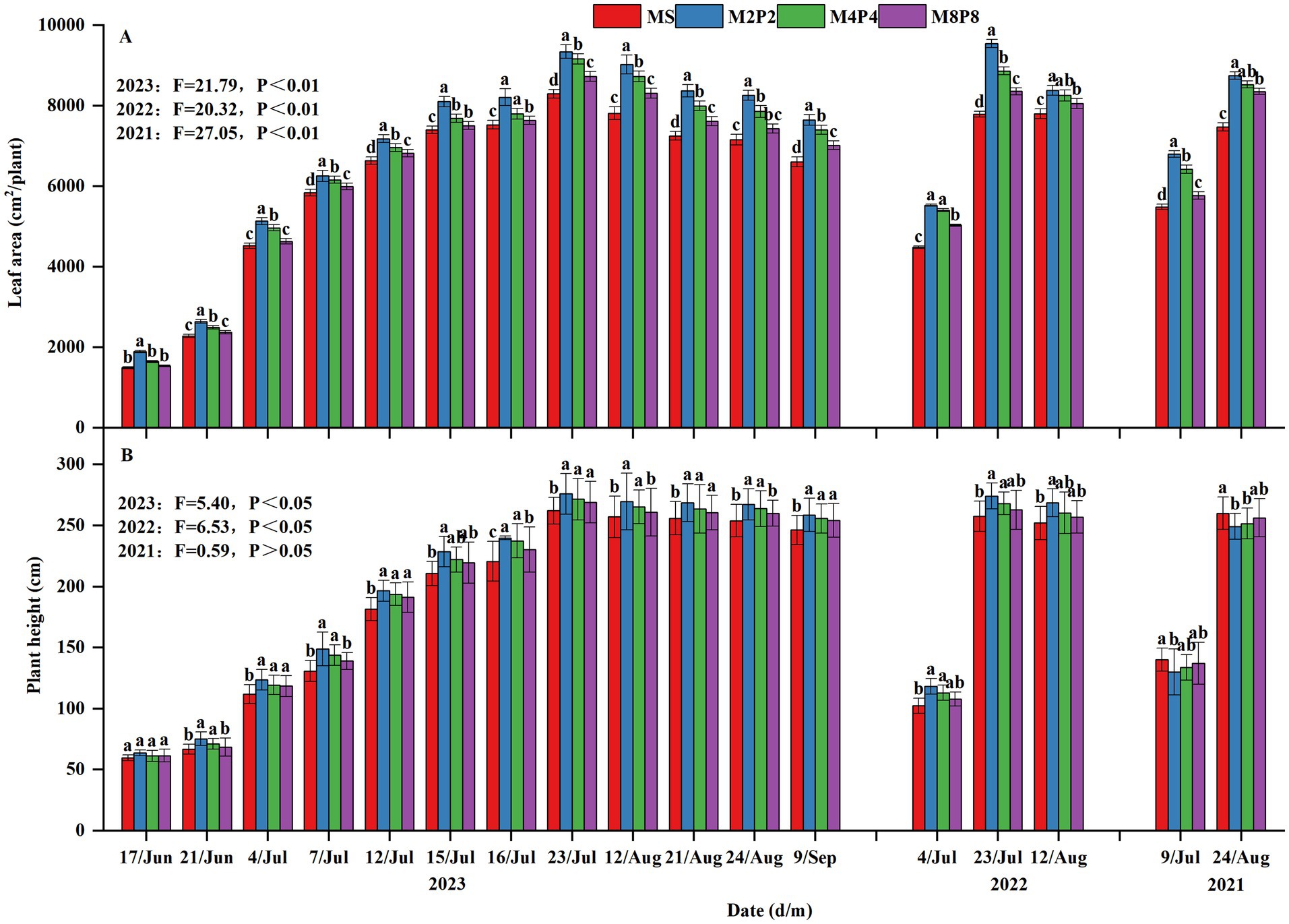
Figure 4. Leaf area (A) and plant height (B) of maize in different treatments. Lowercase letters indicate significant differences among treatments in the same year at p < 0.05 level.
3.3 Effect of width of intercropping on rainfall redistribution
To explore the impact of strip width on rainfall interception in intercropping systems, rainfall redistribution between maize and peanuts was measured 17 times between 2021 and 2023(Not all rainfall events were measured during the three years). The results showed that strip width had a significant impact on stemflow in maize rows and throughfall in both maize and peanut rows (Table 2). The average stemflow in the maize rows of M2P2, M4P4, and M8P8 was 23.7, 14.2, and 5.6% higher than in MS across the 17 rainfall events, while the average throughfall in these maize rows was 12.2, 8.0, and 5.3% higher than in MS. Overall, maize rows in M2P2, M4P4, and M8P8 obtained, on average, 17.4, 10.8, and 5.4% more rainfall compared to MS. Conversely, the peanut rows in M2P2, M4P4, and M8P8 experienced a decrease in throughfall, with averages of 20.6, 13.2, and 7.1%, respectively, compared to PS.
3.4 Relationships between leaf area, plant height, and rainfall redistribution
Leaf area and plant height significantly influenced the redistribution of rainfall between crops(Figures 5, 6). For maize, stemflow rates increased with plant height and leaf area. These relationships were effectively modeled using linear regression (LR), polynomial regression (PR), and exponential regression (ER) equations. Among these, the ER equations exhibited higher R2 values for the relationships between stemflow rates and both plant height and leaf area (Figures 5A,B). In contrast, throughfall rates decreased as plant height and leaf area increased. The LR equations showed a high R2 value for the relationship between throughfall rates and leaf area (Figure 5C), while PR and ER equations demonstrated high R2 values for the relationship between throughfall rates and plant height (Figure 5D). Due to the shading effect of maize canopy on peanut in the intercropping systems, the throughfall rate for peanut decreased as maize height and leaf area increased (Figures 6A,B). PR and ER equations exhibited high R2 values for the relationship between throughfall rate for peanut and maize leaf area, the ER equations showed a high R2 value for the relationship between throughfall rate for peanut and plant height.
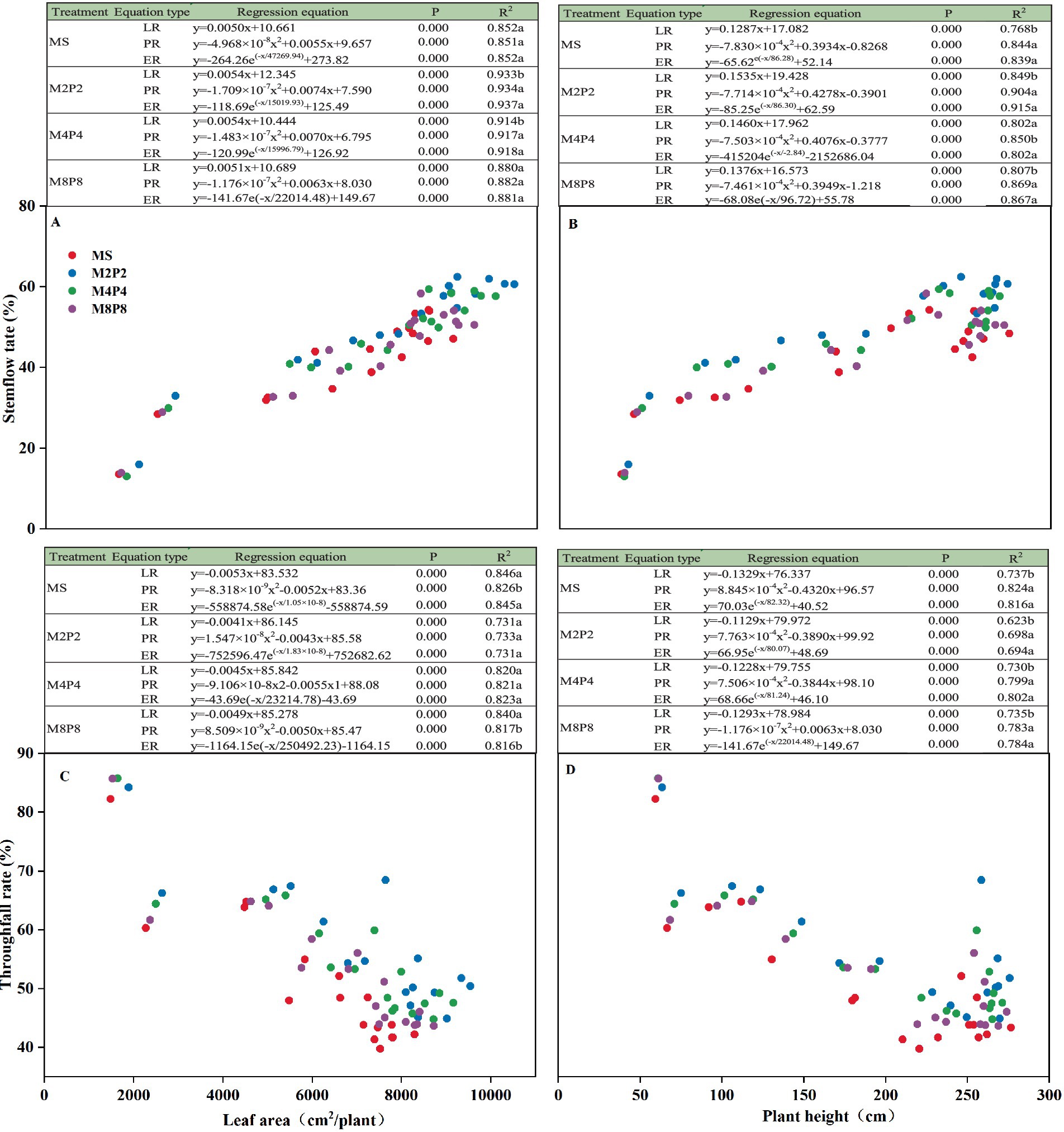
Figure 5. Relationship between maize canopy and rainfall allocation in different treatments. (A), relationship between maize leaf area and maize stemflow rate; (B), relationship between maize plant height and maize stemflow rate; (C), relationship between maize leaf area and maize throughfall rate; (D), relationship between maize plant height and maize throughfall rate. LR, PR, and ER denote the linear regression, polynomial regression, and exponential regression equations, respectively. Lowercase letters indicate significant differences among the R2 values of the regression equations at the p < 0.05 level.
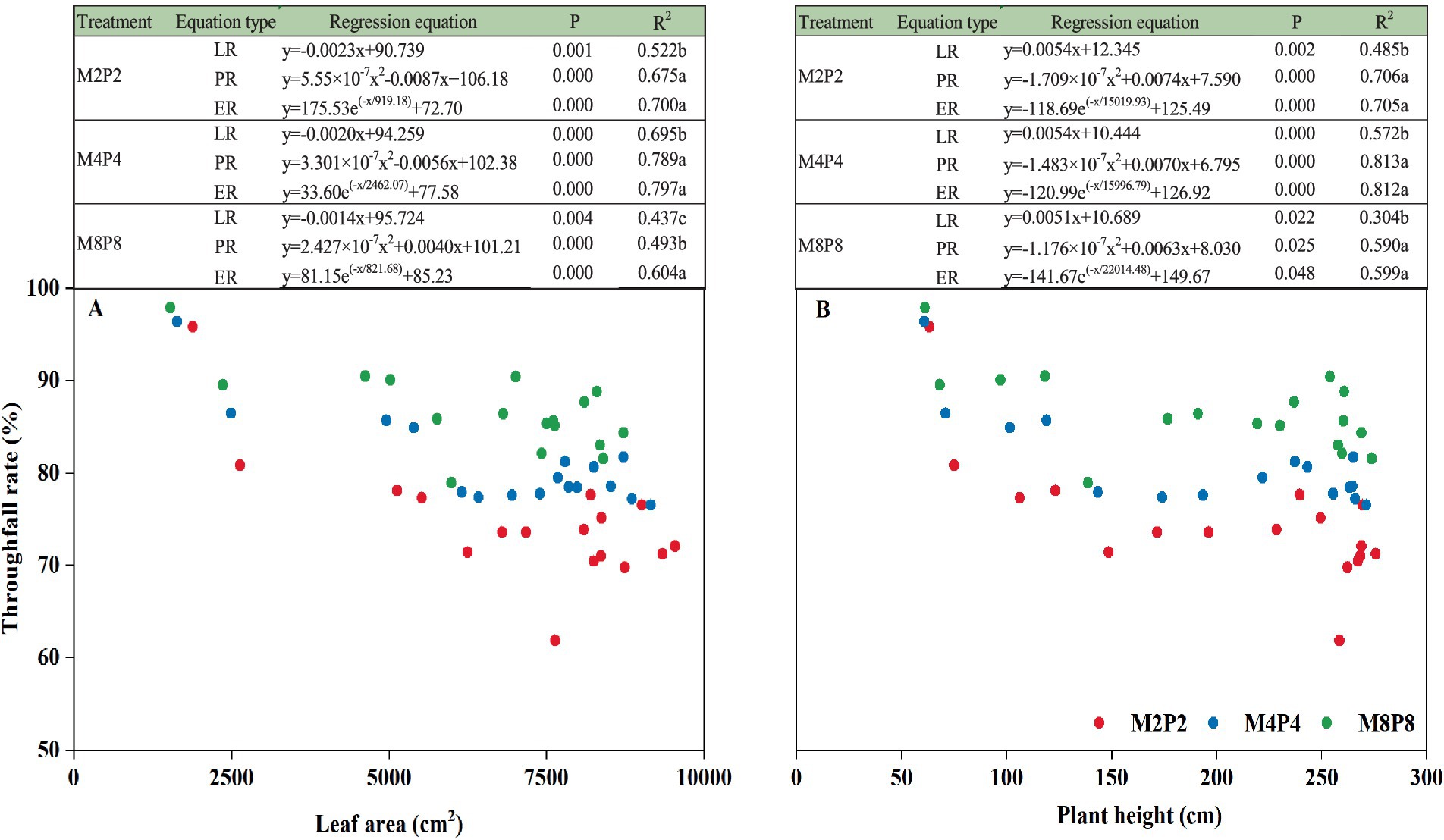
Figure 6. Relationship between maize leaf area (A), and plant height (B) and throughfall rate in peanut strip in different treatments. LR, PR, and ER denote the linear regression, polynomial regression, and exponential regression equations, respectively. Lowercase letters indicate significant differences among the R2 values of the regression equations at the p < 0.05 level.
3.5 Edge effects of rainfall redistribution
The study examined the edge effects on rainfall redistribution in maize-peanut intercropping systems with different strip widths. Based on average data from 17 rainfall events, maize edge rows in the M2P2, M4P4, and M8P8 treatments increased stemflow by 23.7, 17.8, and 14.6%, respectively, compared to MS (Figure 7A). Throughfall increased by 12.2, 10.6, and 8.6%, respectively (Figure 7B). Overall, maize edge rows in M2P2, M4P4, and M8P8 obtained 17.4, 13.8, and 11.3% more rainfall than MS. Intercropping with peanuts significantly reduced throughfall, especially at the edge rows. Compared to PS, throughfall in peanut edge rows in M2P2, M4P4, and M8P8 decreased by 20.6, 18.0, and 16.0%, respectively (Figure 7C).
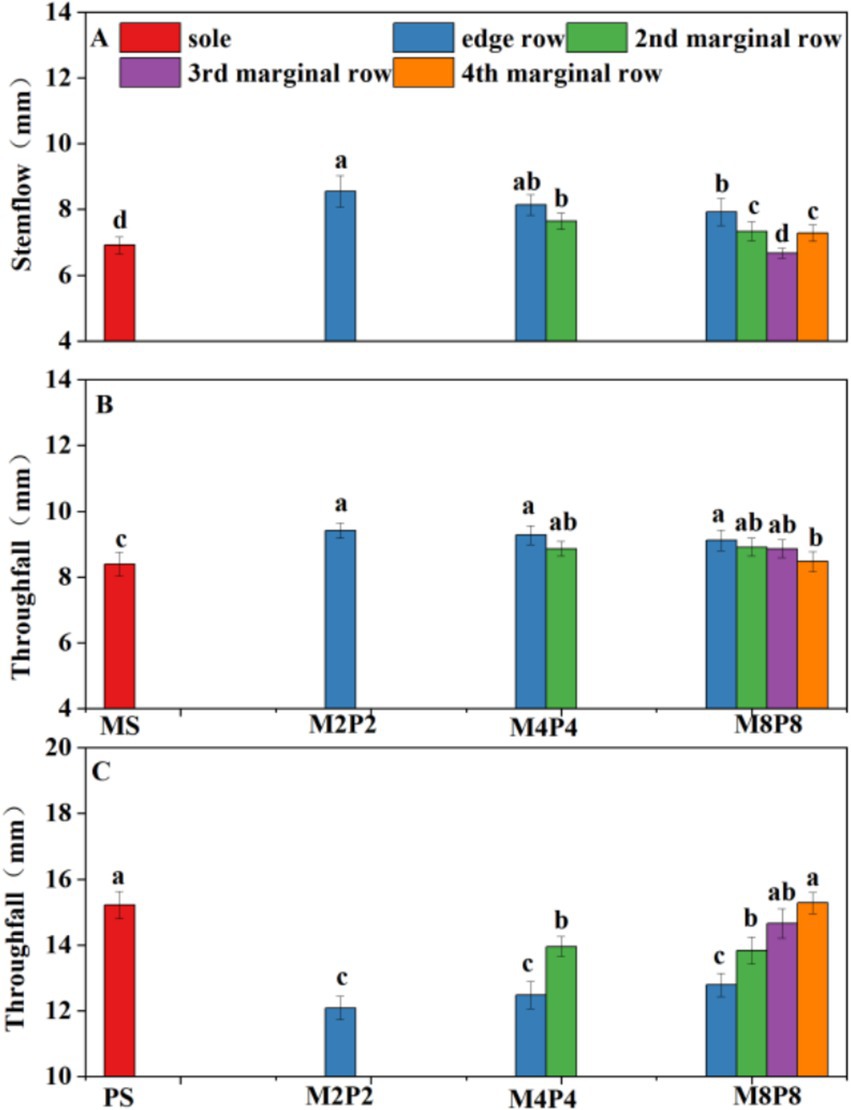
Figure 7. Redistribution characteristics of rainfall in different rows of maize/peanut intercropping (The average of 17 rainfall events). (A) stemflow of maize; (B), throughfall of maize; (C) throughfall of peanut. The lowercase letters indicate significant differences among treatments in the same year at p < 0.05 level.
4 Discussion
Our results indicate that narrower strip widths can increase maize leaf area, regardless of whether the growing season is in a wet or dry year. This suggests that light and space, rather than water availability, are the primary limiting factors for maize leaf extension in the maize-peanut intercropping system studied. Previous research has shown that intercropping with varying strip widths and canopy architectures creates spatial niche differentiation, alters light distribution, and affects yield (Wang et al., 2021; Yang et al., 2024). This suggests that the competitive relationship between intercrops in a specific strip intercropping system is regulated by width configuration (Abakumova et al., 2016). In the narrower strip width intercropping system, as shown in Figure 1, maize plants were less constrained by each other due to the presence of more edge rows. Fu et al. (2023) proposed that high N availability can enhance maize leaf extension in maize-legume intercropping systems. Given that strip width in maize-peanut intercropping has a significant impact on soil N availability and plant N uptake (Zhang et al., 2024c), this may influence maize leaf area. In contrast to leaf area, plant height increased with narrower strip widths during normal and dry years but was not affected by strip width during the wet year. This indicates that water availability is the primary factor controlling plant height in this climate region. Similarly, a study in a high rainfall area by Zou et al. (2024) found that maize-peanut intercropping had no effect on maize height.
Through this experiment, it was found that intercropping can affect the allocation of rainfall between intercrops. Maize-peanut intercropping significantly increased stemflow and throughfall in maize rows, while it reduced throughfall in peanut rows. Maize obtained more rainfall than peanut due to its greater height and canopy, which overshadows the peanut rows. Due to this reason, in most cases, maize received more water than what was provided by rainfall in the maize-peanut intercropping system, with the excess water being taken from the peanut strips. Similar results have been observed in maize-soybean intercropping systems(Wang et al., 2024). We found a positive correlation between maize stemflow and both maize leaf area and plant height, whereas a negative relationship existed between maize and peanut throughfall and maize leaf area and plant height. These findings indicate that more rainfall is allocated to maize rows as maize leaf area and height increase, leading to higher water use efficiency (WUE) in maize and lower WUE in peanuts. This study was conducted in a semi-arid region where water availability is a key limiting factor for crop growth. Maize, being a high water-consuming crop, consistently shows increased WUE with higher water availability (Zhao et al., 2024). Our results support this, as maize WUE increased with narrower strip widths and higher rainfall allocation. However, for peanuts, due to their lower water consumption, no significant difference in WUE was observed between M4P4 and M8P8, regardless of whether it was a wet or dry year, even when rainfall allocation decreased.
In general, the water consumption of sole-cropped maize increases with plant height and leaf area. In intercropping systems, maize can not only capture more rainfall through its canopy but also extract water from peanut strips in the soil during drought periods. In this study, the water consumption of intercropped maize was estimated based on changes in soil moisture content within the intercropping strip. Therefore, it does not represent the actual water consumption of the maize itself. This explains why intercropped maize in this study exhibited large plant height and leaf area but relatively low water consumption. However, relevant research is highly valuable for assessing the water use efficiency of maize-peanut intercropping systems. Mao et al. (2012) provided a detailed explanation of the methods for measuring WU, WUE, and WER (Equations 1–5) in intercropping systems, and their findings are consistent with the results of this study.
Comparing the different strip width treatments over the three years, we found that the M4P4 treatment exhibited the highest system WUE and crop productivity, as indicated by WER and LER. This suggests a balanced resource allocation between the maize and peanut strips. In the M4P4 treatment, approximately 27% of the rainfall from the peanut strip was allocated to the maize strip, resulting in a significant increase in maize yield with minimal impact on peanut yield (Table 1). Additionally, the relatively high WER and LER can be attributed to the edge effect. It is generally understood that the yield-enhancing effect of intercropping is largely due to the edge effect (Wang et al., 2017). Historically, positive edge effects in intercropping systems were thought to arise from differences in how the canopy influenced light interception and distribution (Wang et al., 2020; Zhang et al., 2020). Our research also identified an edge effect on rainfall redistribution within the intercropping system (Figure 8). Compared to M2P2 treatment, maize in the edge row of M4P4 received less water, while peanut rows received more. During drought periods, soil water could flow from the peanut rows to the maize rows, maintaining a steady water supply for maize. However, the long distance between the rows, such as M8P8, limited the movement of water from peanut to maize, while also increasing the potential for evaporation.
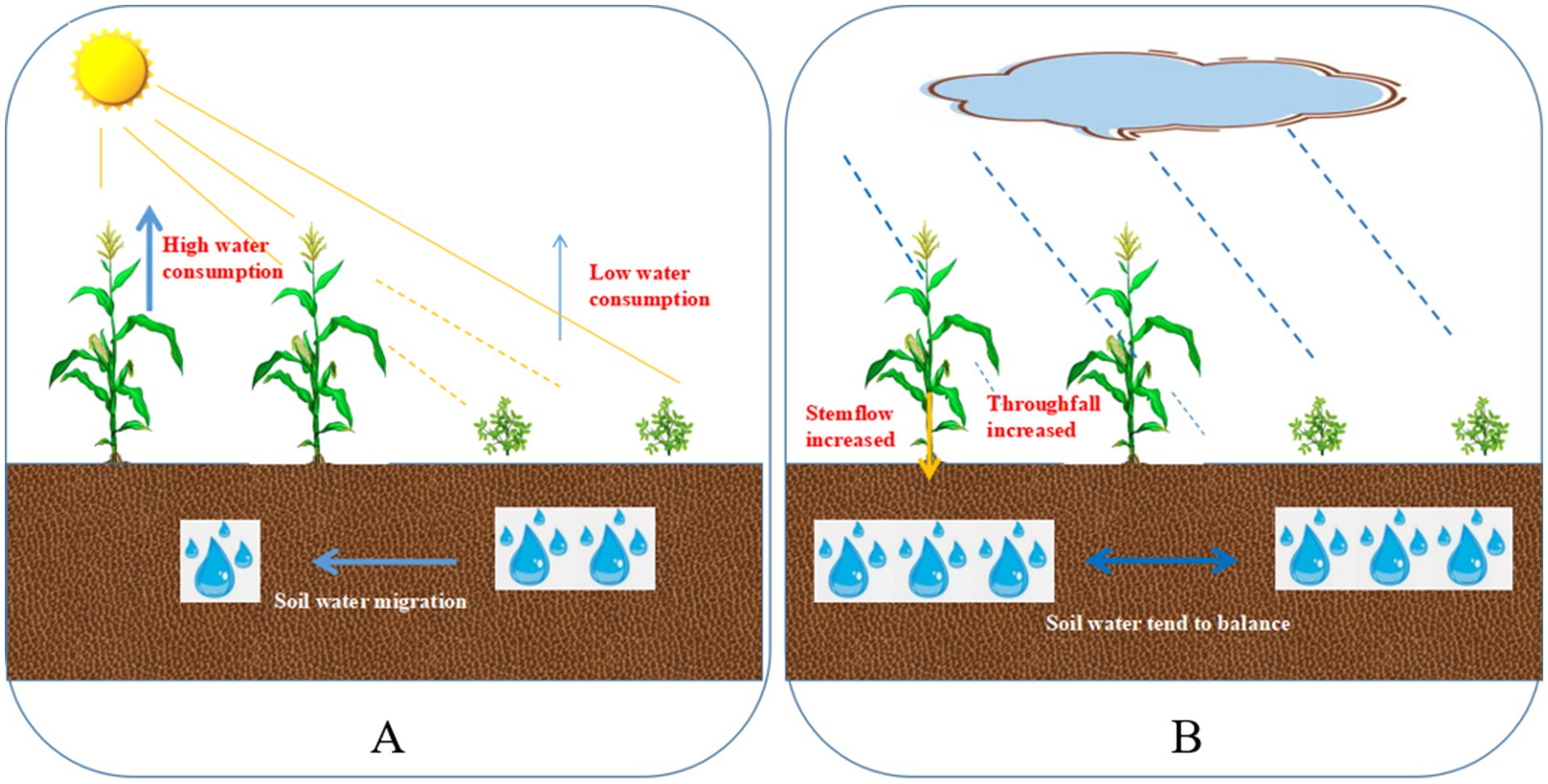
Figure 8. Mechanism of optimizing rainfall allocation in maize-peanut intercropping. (A) before rainfall; (B) during rainfall.
5 Conclusion
This study highlights the significant effects of strip width in maize-peanut intercropping systems on both crop productivity and water use efficiency (WUE). The M4P4 treatment demonstrated the highest system WUE and crop productivity, as evidenced by the higher values of the Land Equivalent Ratio (LER) and Water Equivalent Ratio (WER). The allocation of rainfall from the peanut strips to maize in the M4P4 treatment contributed to a notable increase in maize yield with minimal impact on peanut yield. This result suggests that intercropping with appropriate strip widths can optimize water redistribution, especially during drought periods, benefiting maize while maintaining peanut productivity. Furthermore, the edge effect played a significant role in enhancing yield and water use efficiency in the intercropping system. The maize rows at the edges benefited from the allocation of water, particularly during dry periods, while the peanut rows showed reduced throughfall, further supporting the positive effects of intercropping on water management. However, the long distance between rows in the M4P4 treatment also introduced some limitations, such as increased evaporation potential and restricted water movement between rows. These findings underscore the importance of strip width and edge effects in designing intercropping systems that maximize resource use and enhance crop productivity, particularly in semi-arid regions where water availability is a critical limiting factor.
Overall, the results of this study provide valuable insights for optimizing strip width configurations in intercropping systems. They demonstrate that careful management of spatial arrangements can improve both crop productivity and water use efficiency, with potential applications in sustainable agricultural practices.
Data availability statement
The original contributions presented in the study are included in the article/Supplementary material, further inquiries can be directed to the corresponding author/s.
Author contributions
XS: Data curation, Formal analysis, Writing – original draft. YZ: Writing – review & editing. SZ: Writing – review & editing. NY: Writing – review & editing. GX: Supervision, Writing – review & editing. LF: Funding acquisition, Supervision, Writing – review & editing.
Funding
The author(s) declare that financial support was received for the research and/or publication of this article. National Key Research and Development Program of China (2023YFD1500900); National Natural Science Foundation of China (32071551); Shenyang Science and Technology Plan (23–409–2-06); Liaoning Province Applied Basic Research Program Project (2022022020371-JH2/1013); Liaoning Provincial Natural Science Foundation General Project (2022-MS-055).
Conflict of interest
The authors declare that the research was conducted in the absence of any commercial or financial relationships that could be construed as a potential conflict of interest.
Generative AI statement
The authors declare that no Gen AI was used in the creation of this manuscript.
Publisher’s note
All claims expressed in this article are solely those of the authors and do not necessarily represent those of their affiliated organizations, or those of the publisher, the editors and the reviewers. Any product that may be evaluated in this article, or claim that may be made by its manufacturer, is not guaranteed or endorsed by the publisher.
Supplementary material
The Supplementary material for this article can be found online at: https://www.frontiersin.org/articles/10.3389/fsufs.2025.1502362/full#supplementary-material
References
Abakumova, M., Zobel, K., Lepik, A., and Semchenko, M. (2016). Plasticity in plant functional traits is shaped by variability in neighbourhood species composition. New Phytol. 211, 455–463. doi: 10.1111/nph.13935
Brooker, R. W., Karley, A. J., Pakeman, R. J., and Schöb, C. (2015). Newton a.C. Facilitation and sustainable agriculture: a mechanistic approach to reconciling crop production and conservation. Funct. Ecol. 30, 98–107. doi: 10.1111/1365-2435.12496
Chai, Q., Qin, A., Gan, Y., and Yu, A. (2014). Higher yield and lower carbon emission by intercropping maize with rape, pea, and wheat in arid irrigation areas. Agronomy Sustain 34, 535–543. doi: 10.1007/s13593-013-0161-x
Chauhan, Y. S., Thorburn, P., Biggs, J. S., and Wright, G. C. (2015). Agronomic benefits and risks associated with the irrigated peanut–maize production system under a changing climate in northern Australia. Crop Pasture Sci. 66, 1167–1179. doi: 10.1071/CP15068
Chimi, P. M., Mala, W. A., Fobane, J. L., Abdel, K. N., Nkoué, B. B., Nganmeni, L. F. F., et al. (2024). Factors affecting decision-making to strengthen climate resilience of smallholder farms in the Centre region of Cameroon. Climate Smart Agricul. 1:100004. doi: 10.1016/j.csag.2024.100004
Feng, C., Du, G., Zhang, Y., Feng, L., Zhang, L., Wang, Q., et al. (2024). Maize/Peanut intercropping AffectsLegume nodulation in semi-AridConditions. Agronomy 14:951. doi: 10.3390/agronomy14050951
Feng, C., Sun, Z., Zhang, L., Feng, L., Zheng, J., Bai, W., et al. (2021). Maize/peanut intercropping increases land productivity: a meta-analysis. Field Crop Res. 270:108208. doi: 10.1016/j.fcr.2021.108208
Feng, L., Sun, Z., Zheng, M., Muchoki, M., Zheng, J., Yang, N., et al. (2016). Productivity enhancement and water use efficiency of peanut-millet intercropping. Pak. J. Bot. 48, 1459–1466.
Franco, J. G., King, S. R., and Volder, A. (2018). Component crop physiology and water use efficiency in response to intercropping. Eur. J. Agron. 93, 27–39. doi: 10.1016/j.eja.2017.11.005
Fu, Z., Chen, P., Zhang, X., Du, Q., Zheng, B., Yang, H., et al. (2023). Maize-legume intercropping achieves yield advantages by improving leaf functions and dry matter partition. BMC Plant Biol. 23:438. doi: 10.1186/s12870-023-04408-3
Gao, X. B., Guo, C., Li, F. M., Li, M., and He, J. (2020). High soybean yield and drought adaptation being associated with canopy architecture, water uptake, and root traits. Agronomy 10:608. doi: 10.3390/agronomy10040608
Guo, M., He, J., Dong, K., Yang, N., Li, Y., Xiao, J., et al. (2023). Factors influencing maize stemflow in western Liaoning, China. Agronom. J. 115, 2708–2720. doi: 10.1002/agj2.21234
Hamd-Alla, W., Shehata, M. A., Leilah, A. A., Darwesh, R. K., and Hefzy, M. (2023). Impact of irrigation regimes on productivity and profitability of maize+ peanut intercropping system in upper Egypt. Eur. J. Biol. Res. 13, 218–231. doi: 10.5281/zenodo.10413383
Lamm, F. R., and Manges, H. L. (2000). Partitioning of the sprinkler irrigation water by a corn canopy. Transact ASAE 43, 909–918. doi: 10.13031/2013.2987
Lou, Y., Wen, X., Hao, W., Mei, X., Feng, L., Sun, Z., et al. (2024). Climate-smart agriculture: insights and challenges. Climate Smart Agriculture. 1:100003. doi: 10.1016/j.csag.2024.100003
Lu, S., and Shi, W. (2024). Modeling the effects of the plastic-mulched cropland over the arid and semi-arid areas of China on the east Asian regional climate. J. Hydrol. 634:131123. doi: 10.1016/j.jhydrol.2024.131123
Ma, L., Li, Y., Wu, P., Zhao, X., Chen, X., and Gao, X. (2019). Effects of varied water regimes on root development and its relations with soil water under wheat/maize intercropping system. Plant Soil 439, 113–130. doi: 10.1007/s11104-018-3800-9
MacArthur, R. (1955). Fluctuations of animal populations, and a measure of community stability. Ecology 36, 533–536. doi: 10.2307/1929601
Mao, L., Zhang, L., Li, W., van der Werf, W., Sun, J., Spiertz, H., et al. (2012). Yield advantage and water saving in maize/pea intercrop. Field Crop Res. 138, 11–20. doi: 10.1016/j.fcr.2012.09.019
Nanko, K., Hudson, S. A., and Levia, D. F. (2016). Differences in throughfall drop size distributions in the presence and absence of foliage. Hydrol. Sci. J. 61, 620–627. doi: 10.1080/02626667.2015.1052454
Nehe, A. S., Foulkes, M. J., Ozturk, I., Rasheed, A., York, L., Kefauver, S. C., et al. (2021). Root and canopy traits and adaptability genes explain drought tolerance responses in winter wheat. PLoS One 16:e0242472. doi: 10.1371/journal.pone.0242472
Nelson, W. C. D., Hoffmann, M. P., Vadez, V., Roetter, R. P., and Whitbread, A. M. (2018). Testing pearl millet and cowpea intercropping systems under high temperatures. Field Crop Res. 217, 150–166. doi: 10.1016/j.fcr.2017.12.014
Nelson, W. C., Hoffmann, M. P., Vadez, V., Rötter, R. P., Koch, M., and Whitbread, A. M. (2022). Can intercropping be an adaptation to drought? A model-based analysis for pearl millet–cowpea. J. Agron. Crop Sci. 208, 910–927. doi: 10.1111/jac.12552
Odum, E. R. (1953). Fundamentals of ecology. Philadelphia: Saunders. doi: 10.1126/science.129.3359.1354.a
Pelech, E. A., Evers, J. B., Pederson, T. L., Drag, D. W., Fu, P., and Bernacchi, C. J. (2023). Leaf, plant, to canopy: a mechanistic study on aboveground plasticity and plant density within a maize–soybean intercrop system for the Midwest, USA. Plant Cell Environ. 46, 405–421. doi: 10.1111/pce.14487
Ren, Y. Y., Wang, X. L., Zhang, S. Q., Palta, J. A., and Chen, Y. L. (2017). Influence of spatial arrangement in maize-soybean intercropping on root growth and water use efficiency. Plant Soil 415, 131–144. doi: 10.1007/s11104-016-3143-3
Renwick, L. L., Kimaro, A. A., Hafner, J. M., Rosenstock, T. S., and Gaudin, A. C. (2020). Maize-pigeonpea intercropping outperforms monocultures under drought. Front. Sustain. Food Syst. 4:562663. doi: 10.3389/fsufs.2020.562663
Tahir, M., Lv, Y., Gao, L., Hallett, P. D., and Peng, X. (2016). Soil water dynamics and availability for citrus and peanut along a hillslope at the Sunjia red soil critical zone observatory (CZO). Soil Tillage Res. 163, 110–118. doi: 10.1016/j.still.2016.05.017
Wang, J., Liu, Y., Li, B., Li, Z., Zhang, Y., Zhang, S., et al. (2024). The Throughfall, Stemflow, and canopy interception loss in corn and soybean fields in Northeast China. Water 16:253. doi: 10.3390/w16020253
Wang, R., Sun, Z., Bai, W., Wang, E., Wang, Q., Zhang, D., et al. (2021). Canopy heterogeneity with border-row proportion affects light interception and use efficiency in maize/peanut strip intercropping. Field Crop Res. 271:108239. doi: 10.1016/j.fcr.2021.108239
Wang, R., Sun, Z., Zhang, L., Yang, N., Feng, L., Bai, W., et al. (2020). Border-row proportion determines strength of interspecific interactions and crop yields in maize/peanut strip intercropping. Field Crop Res. 253:107819. doi: 10.1016/j.fcr.2020.107819
Wang, Y., Zhao, Z., Li, J., Zhang, M., Zhou, S., Wang, Z., et al. (2017). Does maize hybrid intercropping increase yield due to border effects? Field Crop Res. 214, 283–290. doi: 10.1016/j.fcr.2017.09.023
Xia, H. Y., Zhao, J. H., Sun, J. H., Bao, X. G., Christie, P., Zhang, F. S., et al. (2013). Dynamics of root length and distribution and shoot biomass of maize as affected by intercropping with different companion crops and phosphorus application rates. Field Crop Res. 150, 52–62. doi: 10.1016/j.fcr.2013.05.027
Yang, F., Liao, D., Wu, X., Gao, R., Fan, Y., Raza, M. A., et al. (2017). Effect of aboveground and belowground interactions on the intercrop yields in maize-soybean relay intercropping systems. Field Crop Res. 203, 16–23. doi: 10.1016/j.fcr.2016.12.007
Yang, S., Zhao, Y., Xu, Y., Cui, J., Li, T., Hu, Y., et al. (2024). Yield performance response to field configuration of maize and soybean intercropping in China: a meta-analysis. Field Crop Res. 306:109235. doi: 10.1016/j.fcr.2023.109235
Ye, H., Song, L., Schapaugh, W. T., Ali, M. L., Sinclair, T. R., Riar, M. K., et al. (2020). The importance of slow canopy wilting in drought tolerance in soybean. J. Exp. Bot. 71, 642–652. doi: 10.1093/jxb/erz150
Zhang, C., Gao, J., Liu, L., and Wu, S. (2024a). Compound drought and hot stresses projected to be key constraints on maize production in Northeast China under future climate. Comput. Electron. Agric. 218:108688. doi: 10.1016/j.compag.2024.108688
Zhang, W. P., Liu, G. C., Sun, J. H., Fornara, D., Zhang, L. Z., Zhang, F. F., et al. (2017). Temporal dynamics of nutrient uptake by neighbouring plant species: evidence from intercropping. Funct. Ecol. 31, 469–479. doi: 10.1111/1365-2435.12732
Zhang, D., Sun, Z., Feng, L., Bai, W., Yang, N., Zhang, Z., et al. (2020). Maize plant density affects yield, growth and source-sink relationship of crops in maize/peanut intercropping. Field Crop Res. 257:107926. doi: 10.1016/j.fcr.2020.107926
Zhang, Y., Zhao, F., Feng, C., Bai, W., Zhang, Z., Cai, Q., et al. (2024b). Effects of maize/Peanut intercropping and nitrogen fertilizer application on soil fungal community structure. Agronomy 14:1053. doi: 10.3390/agronomy14051053
Zhang, Y., Zhao, F., Sun, Z., Bai, W., Zhang, Z., Feng, C., et al. (2024c). Effects of maize/Peanut intercropping on yield and nitrogen uptake and utilization under different nitrogen application rates. Agriculture 14:893. doi: 10.3390/agriculture14060893
Zhao, Z., Li, Z., Li, Y., Yu, L., Gu, X., and Cai, H. (2024). Supplementary irrigation and reduced nitrogen application improve the productivity, water and nitrogen use efficiency of maize-soybean intercropping system in the semi-humid drought-prone region of China. Agricultural water management, vol. 305, 109126. doi: 10.1016/j.agwat.2024.109126
Zhu, Z., Zhu, D., and Ge, M. (2021). The spatial variation mechanism of size, velocity, and the landing angle of throughfall droplets under maize canopy. Water 13:2083. doi: 10.3390/w13152083
Keywords: intercropping, canopy, strip width, stemflow, throughfall, maize, peanut
Citation: Sun X, Zhang Y, Zhang S, Yang N, Xia G and Feng L (2025) Effect of strip width in maize/peanut intercropping on water use efficiency. Front. Sustain. Food Syst. 9:1502362. doi: 10.3389/fsufs.2025.1502362
Edited by:
Libert Brice Tonfack, University of Yaoundé 1, CameroonReviewed by:
Sowmyalakshmi Subramanian, McGill University, CanadaWayan Wangiyana, University of Mataram, Indonesia
Copyright © 2025 Sun, Zhang, Zhang, Yang, Xia and Feng. This is an open-access article distributed under the terms of the Creative Commons Attribution License (CC BY). The use, distribution or reproduction in other forums is permitted, provided the original author(s) and the copyright owner(s) are credited and that the original publication in this journal is cited, in accordance with accepted academic practice. No use, distribution or reproduction is permitted which does not comply with these terms.
*Correspondence: Guimin Xia, eGlhZ20xMjI5QHN5YXUuZWR1LmNu; Liangshan Feng, ZmVuZ2xzaEAxNjMuY29t
 Xianglong Sun1
Xianglong Sun1 Yongyong Zhang
Yongyong Zhang Liangshan Feng
Liangshan Feng